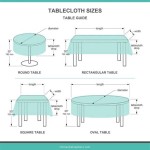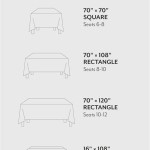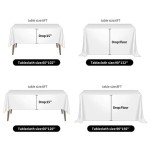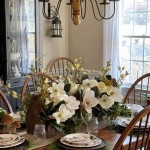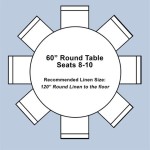How to Choose the Perfect Patio Dining Table: Round or Rectangular
Selecting the right patio dining table involves careful consideration of several factors, including the size and shape of the outdoor space, the number of individuals typically accommodated, and the desired aesthetic. The decision between a round and a rectangular table is paramount, as each shape offers distinct advantages and disadvantages in terms of space utilization, social interaction, and overall design.
This article aims to provide a comprehensive guide to choosing the ideal patio dining table, exploring the key differences between round and rectangular options to assist homeowners in making an informed decision that complements their outdoor living area and lifestyle.
Understanding Space Constraints and Patio Dimensions
Before evaluating the stylistic merits of each shape, it is essential to assess the available space on the patio. The dimensions and configuration of the outdoor area significantly impact the suitability of round versus rectangular tables. A common mistake is underestimating the space required to comfortably accommodate both the table and the chairs surrounding it.
Rectangular tables, due to their elongated shape, are generally more suited for narrow or long patios. They can be positioned effectively along the length of the space, maximizing seating capacity without obstructing walkways. However, in smaller, square-shaped patios, a rectangular table might overwhelm the area, leaving limited room for movement and other outdoor furniture.
Round tables, conversely, excel in smaller or square patios. Their circular form allows for efficient space utilization, promoting a more open and inviting atmosphere. The absence of corners allows individuals to navigate around the table easily, preventing awkward bumping and maximizing the sense of flow within the outdoor space. Furthermore, round tables often create a more intimate setting, fostering conversation and connection among diners. It is important to note, however, that very large round tables can sometimes feel isolating, as individuals seated at opposite sides may find it difficult to interact.
When measuring the patio, it is crucial to factor in the "buffer zone" – the space needed for pulling out chairs and walking around the table comfortably. A minimum of 3 feet is generally recommended between the edge of the table and any walls or obstructions. This buffer ensures a comfortable dining experience and prevents overcrowding.
Consider the overall layout of the patio. Does it primarily serve as a dining area, or is it intended for multiple purposes, such as lounging, grilling, or gardening? If the patio serves multiple functions, the table's size and shape should be carefully chosen to optimize space utilization and maintain a cohesive design.
Evaluating Seating Capacity and Social Dynamics
The number of individuals typically accommodated at the patio dining table is a critical factor in determining the optimal shape. Rectangular tables tend to offer greater seating capacity, making them ideal for larger families or those who frequently entertain guests. The elongated shape allows for easy addition or removal of chairs as needed, providing flexibility for various group sizes.
While round tables can accommodate a decent number of people, their capacity is generally lower than that of rectangular tables of similar overall size. Adding extra chairs around a round table can sometimes result in a crowded and uncomfortable dining experience, as legroom may be compromised. Furthermore, the circular shape inherently limits the number of individuals who can comfortably seat around the table.
Beyond pure seating capacity, the shape of the table also influences social dynamics. Round tables promote a sense of equality and inclusivity, as everyone is equidistant from the center and can easily see and interact with each other. This configuration fosters conversation and creates a more intimate and connected dining experience. Round tables are particularly well-suited for gatherings where fostering a sense of community is a priority.
Rectangular tables, on the other hand, can sometimes create a sense of hierarchy, with individuals seated at the ends potentially assuming a more dominant role. While this may not be a significant concern for casual gatherings, it is a factor to consider when planning formal dinner parties or events where promoting a sense of equality and collaboration is important. However, rectangular tables also facilitate a more formal dining experience, and can be ideal for more structured and elaborate meals.
Consider how the patio dining table will be used. Will it primarily serve as a space for family meals, or will it be used for larger gatherings and social events? The frequency and nature of these gatherings will influence the optimal seating capacity and social dynamics considerations, and ultimately help determine the best choice between a round and a rectangular table.
Assessing Aesthetic Preferences and Design Integration
The aesthetic appeal of the patio dining table plays a significant role in enhancing the overall ambiance of the outdoor space. The choice between a round and a rectangular table should complement the existing design elements of the patio, including the style of the house, the surrounding landscaping, and the other outdoor furniture.
Rectangular tables tend to convey a sense of formality and sophistication, often associated with traditional or contemporary design styles. Their clean lines and geometric shape create a sense of order and structure, making them well-suited for patios with a more formal or minimalist aesthetic. Rectangular tables can also be paired with various chair styles, from classic wooden chairs to modern metal or wicker designs, offering versatility in terms of design integration.
Round tables, conversely, evoke a more relaxed and inviting atmosphere, often associated with bohemian, cottage, or coastal design styles. Their organic shape and soft curves create a sense of warmth and intimacy, making them ideal for patios with a more relaxed or informal aesthetic. Round tables tend to blend seamlessly with natural surroundings, complementing lush greenery and soft lighting. They also work well with a variety of chair styles, although curved or rounded chairs often complement the shape of the table more effectively.
Consider the materials used in the construction of the table. Wood, metal, and stone are all common materials for patio dining tables, each offering distinct aesthetic qualities. Wooden tables tend to convey a sense of warmth and natural beauty, while metal tables offer a sleek and modern look. Stone tables provide a sense of durability and permanence, adding a touch of elegance to the outdoor space.
The color of the table should also be carefully considered. Neutral colors, such as beige, gray, or white, tend to blend seamlessly with any outdoor setting, while bolder colors can add a pop of visual interest. It is important to choose a color that complements the existing color palette of the patio and the surrounding landscape. Consider integrating coordinating placemats, tablecloths, or runners to further enhance the table's visual appeal and create a cohesive design.
Ultimately, the choice between a round and a rectangular patio dining table depends on individual aesthetic preferences and the desired overall ambiance of the outdoor space. By carefully considering the existing design elements of the patio and selecting a table that complements those elements, homeowners can create a stylish and inviting outdoor dining area that reflects their personal taste and lifestyle.
Beyond these core factors, further considerations may influence the selection process. Table height, for example, should correspond to the height of the accompanying chairs for optimal dining comfort. Similarly, table materials should be evaluated for their durability and weather resistance, ensuring longevity and minimal maintenance. Finally, the presence of an umbrella hole can provide shade during sunny days, increasing overall comfort and usability of the patio dining area.

Complete Guide To Patio Tables Bonus Styling Tips

How To Choose The Right Outdoor Dining Table For You A Complete Guide Abide Interiors

Best Patio Dining Sets 2025 Forbes Vetted

Complete Guide To Patio Tables Bonus Styling Tips

Key Measurements For Designing Your Perfect Patio

Complete Guide To Patio Tables Bonus Styling Tips

Complete Guide To Patio Tables Bonus Styling Tips

Finding The Right Oak Table For Your Garden Gaze Burvill

Best Outdoor Dining In Brooklyn Seating Restaurants S

Expert Advice How To Design A Perfectly Scaled Dining Room The Kuotes Blog
Related Posts


